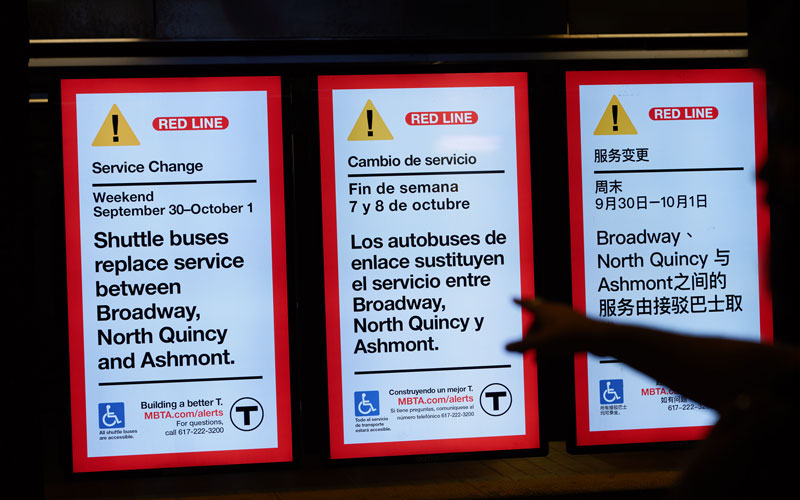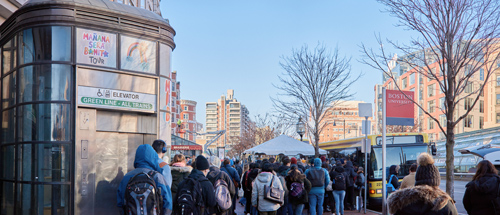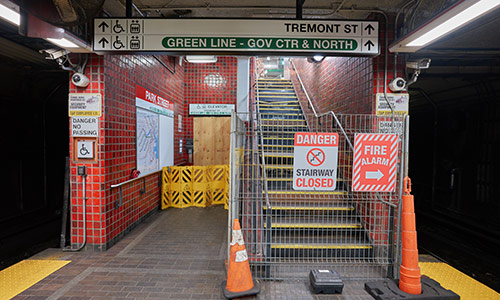
As the MBTA conducts much-needed repair and maintenance work, ensuring riders can stay safe and connected should be a priority. Photo: Jarvis Chen.
Earlier this year, MBTA officials announced an ambitious New Year’s resolution: eliminate slow zones. The agency plans to accomplish this herculean task by incrementally shutting down portions of the T across four lines. The scheduled repairs mean that throughout 2024, riders will face at least 188 days of MBTA closures. These shutdowns for critical track and infrastructure repair will result in faster and safer service, which is an important goal.
The fact that the T shared their closure calendar for the entire year shows that the agency is learning from past debacles. Remember the Orange Line fiasco? It was forced to shut down as an emergency measure after a train caught fire. Back then, commuters paid the price with long waits for shuttle buses and labyrinthine alternate routes.
This latest effort to communicate closures for 2024 ahead of time represents a step in the right direction. But there’s still work ahead. The T needs to substantially level up to get an antiquated system back into good repair. Here are 5 T’s the MBTA must prioritize so that much-needed repairs are as painless as possible for my fellow commuters and me.
1. Timely Announcements
Communication is key. Passengers and communities rely on the MBTA to get to work, school, and necessary appointments. Any disruption can have major ripple effects. The MBTA must inform the public well before closures, as it did for the 2024 scheduled repairs. That’s the only way people can have time to adjust their plans, arrange alternate routes, and prevent chaos – especially during the busy morning and evening commutes.

2. Transit Alternatives
Safety repairs should not mean a near absence of service – as has been the case. When the MBTA first announced the 42-day shutdown of the newly opened Green Line branch to Union Square, it offered no additional shuttle buses to help riders navigate the closure.
Passengers should never be stranded – particularly in New England’s ever-changing weather. During closures, the MBTA must ensure robust shuttle service or transit alternatives – including shuttles that can accommodate disabled riders – to minimize the impact on people’s lives. Alternatives should also have clear signage, so riders don’t wander around in confusion.
In the case of the planned closures, the T should also increase Commuter Rail service (free of cost) on lines that run along impacted neighborhoods. Adding more Bluebikes along affected routes could provide commuters with alternatives.
What’s more, when closures force riders to take a shuttle in the middle of their commute, they shouldn’t have to pay twice. That’s exactly what happened during the recent partial shutdowns of the Red, Green, and Orange lines.
3. Transparency
Honesty builds trust. And the MBTA’s credibility has taken more than a few hits. Last year, the MBTA announced a closure of the Blue Line between Bowdoin and Airport stations to conduct harbor tunnel repairs. The agency initially scheduled work for two weeks but delayed the reopening twice – with little communication about why.
But the recent 16-day shutdown of Red Line’s Ashmont branch makes me hopeful. Not only did repairs stay on track, but they also effectively eliminated slow zones! The MBTA should provide clear answers about the duration of closures, expected completion dates (even if they are long), and actual outcomes. Communities deserve to know what to expect so they can plan accordingly. A monthly pass holds little value when the only line serving your community isn’t running for most of the month.
4. Translation
Navigating service disruptions is already challenging – imagine doing it in an unfamiliar language. The upcoming closures will affect neighborhoods and cities (Chinatown, East Boston, Quincy, Malden) where many speak Chinese, Haitian Creole, Portuguese, and Spanish as their primary language.
Not only should translation happen, but it needs to be timely. During the Orange Line shutdown, many Mandarin and Cantonese speakers learned about the closure weeks later (through a live translator), leaving them with less than two days’ notice to prepare.
Boston’s diverse culture and communities make this city a unique place where a tapestry of languages is spoken. Nearly 20% of Boston residents don’t speak English as their primary language. The MBTA’s announcements should reflect this reality.
Ensuring that information about closures, service changes, and shuttles is available in multiple languages helps ensure those who don’t speak English can stay connected, too.
5. Thinking Ahead
The past should guide the future. Significant disruptions to transit service should not be the norm – but currently, and in the foreseeable future, they will continue to be. With careful planning and proactive maintenance, the MBTA can prevent future lengthy closures. Regular safety checks and maintenance during non-peak hours (including at night when the trains and buses don’t run) can prevent emergencies and unexpected shutdowns.
The coming year of MBTA closures serves as a reminder that repairs and maintenance are essential. While we appreciate the efforts to improve safety, our community deserves a transit system that anticipates challenges well before they happen and deftly rises above them. The MBTA’s commitment to its riders should extend beyond short-term fixes and embrace a holistic, forward-thinking approach.

The MBTA administration must strive to do better. Following these 5 T’s is the bare minimum for what we deserve: a safe and reliable transit system accessible to all.



